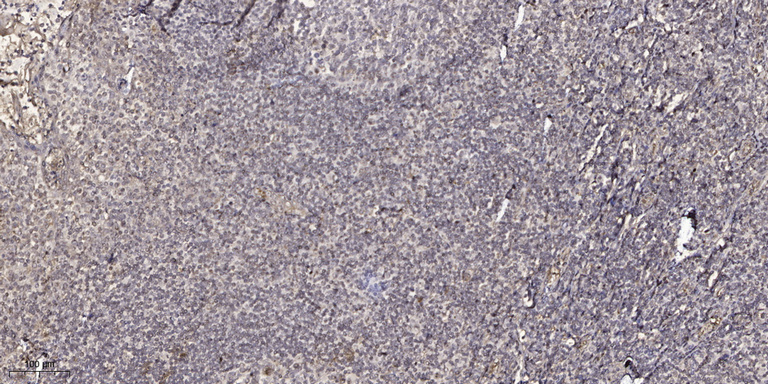CEL Polyclonal Antibody
- Catalog No.:YT0850
- Applications:IHC;IF;ELISA
- Reactivity:Human;Rat;Mouse;
- Target:
- CEL
- Fields:
- >>Steroid biosynthesis;>>Glycerolipid metabolism;>>Metabolic pathways;>>Pancreatic secretion;>>Fat digestion and absorption
- Gene Name:
- CEL
- Protein Name:
- Bile salt-activated lipase
- Human Gene Id:
- 1056
- Human Swiss Prot No:
- P19835
- Mouse Swiss Prot No:
- Q64285
- Immunogen:
- Synthesized peptide derived from the Internal region of human CEL.
- Specificity:
- CEL Polyclonal Antibody detects endogenous levels of CEL protein.
- Formulation:
- Liquid in PBS containing 50% glycerol, 0.5% BSA and 0.02% sodium azide.
- Source:
- Polyclonal, Rabbit,IgG
- Dilution:
- IHC 1:100 - 1:300. ELISA: 1:40000.. IF 1:50-200
- Purification:
- The antibody was affinity-purified from rabbit antiserum by affinity-chromatography using epitope-specific immunogen.
- Concentration:
- 1 mg/ml
- Storage Stability:
- -15°C to -25°C/1 year(Do not lower than -25°C)
- Other Name:
- CEL;BAL;Bile salt-activated lipase;BAL;Bile salt-stimulated lipase;BSSL;Bucelipase;Carboxyl ester lipase;Cholesterol esterase;Pancreatic lysophospholipase;Sterol esterase
- Molecular Weight(Da):
- 78kD
- Background:
- The protein encoded by this gene is a glycoprotein secreted from the pancreas into the digestive tract and from the lactating mammary gland into human milk. The physiological role of this protein is in cholesterol and lipid-soluble vitamin ester hydrolysis and absorption. This encoded protein promotes large chylomicron production in the intestine. Also its presence in plasma suggests its interactions with cholesterol and oxidized lipoproteins to modulate the progression of atherosclerosis. In pancreatic tumoral cells, this encoded protein is thought to be sequestrated within the Golgi compartment and is probably not secreted. This gene contains a variable number of tandem repeat (VNTR) polymorphism in the coding region that may influence the function of the encoded protein. [provided by RefSeq, Jul 2008],
- Function:
- catalytic activity:A steryl ester + H(2)O = a sterol + a fatty acid.,catalytic activity:Triacylglycerol + H(2)O = diacylglycerol + a carboxylate.,disease:Defects in CEL are a cause of maturity-onset diabetes of the young type 8 with exocrine dysfunction (MODY8) [MIM:609812]; also known as diabetes and pancreatic exocrine dysfunction (DPED). MODY [MIM:606391] is an autosomal dominant form of diabetes mellitus. The pancreas serves both endocrine and exocrine functions. The endocrine cells are found in the islets of Langerhans. They synthesize insulin and other hormones, and are involved in the pathogenesis of diabetes mellitus. The exocrine cells produce bicarbonate and digestive enzymes and are involved in the pathogenesis of pancreatic malabsorption. The localization of the islets within exocrine pancreatic tissue is suggestive of an interdependency and cross-talk between these two cell
- Subcellular Location:
- Secreted .
- Expression:
- Mammary gland and pancreas. Detected in pancreatic and duodenal juice (at protein level) (PubMed:21784842). Expressed by eosinophils.
- June 19-2018
- WESTERN IMMUNOBLOTTING PROTOCOL
- June 19-2018
- IMMUNOHISTOCHEMISTRY-PARAFFIN PROTOCOL
- June 19-2018
- IMMUNOFLUORESCENCE PROTOCOL
- September 08-2020
- FLOW-CYTOMEYRT-PROTOCOL
- May 20-2022
- Cell-Based ELISA│解您多样本WB检测之困扰
- July 13-2018
- CELL-BASED-ELISA-PROTOCOL-FOR-ACETYL-PROTEIN
- July 13-2018
- CELL-BASED-ELISA-PROTOCOL-FOR-PHOSPHO-PROTEIN
- July 13-2018
- Antibody-FAQs
- Products Images

- Immunohistochemical analysis of paraffin-embedded human tonsil. 1, Antibody was diluted at 1:200(4° overnight). 2, Tris-EDTA,pH9.0 was used for antigen retrieval. 3,Secondary antibody was diluted at 1:200(room temperature, 30min).



